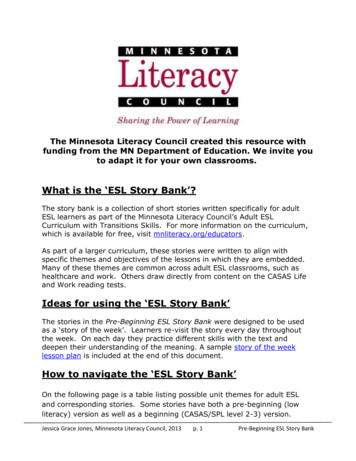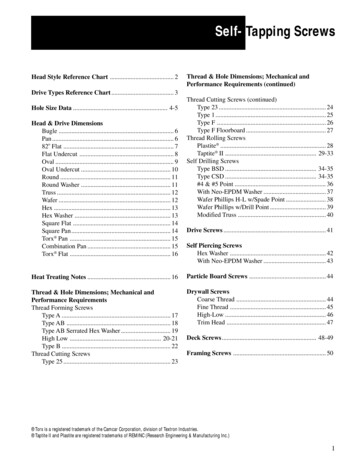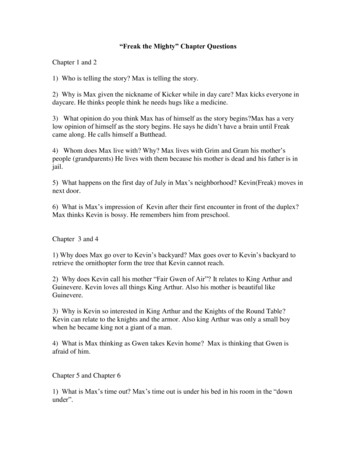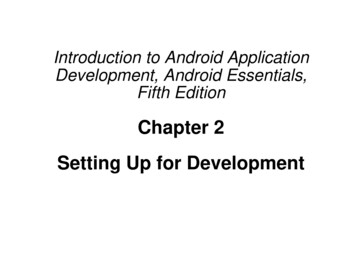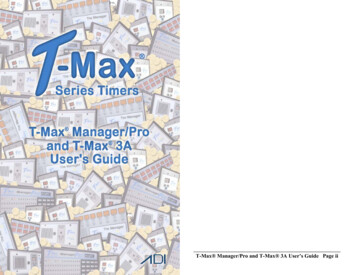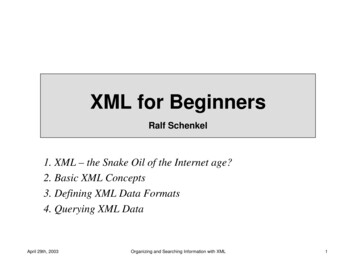
Transcription
XML for BeginnersRalf Schenkel1. XML – the Snake Oil of the Internet age?2. Basic XML Concepts3. Defining XML Data Formats4. Querying XML DataApril 29th, 2003Organizing and Searching Information with XML1
Snake Oil? Snake Oil is the all-curing drug these strange guys inwild-west movies sell, travelling from town to town, butvisiting each town only once. Google: „snake oil“ xml some 2000 hits „XML revolutionizes software development“ „XML is the all-healing, world-peace inducing tool forcomputer processing“ „XML enables application portability“ „Forget the Web, XML is the new way to business“ „XML is the cure for your data exchange, informationintegration, data exchange, [x-2-y], [you name it] problems“ „XML, the Mother of all Web Application Enablers“ „XML has been the best invention since sliced bread“April 29th, 2003Organizing and Searching Information with XML2
XML is not A replacement for HTML(but HTML can be generated from XML) A presentation format(but XML can be converted into one) A programming language(but it can be used with almost any language) A network transfer protocol(but XML may be transferred over a network) A database(but XML may be stored into a database)April 29th, 2003Organizing and Searching Information with XML3
But then – what is it?XML is a meta markup languagefor text documents / textual dataXML allows to define languages(„applications“) to represent textdocuments / textual dataApril 29th, 2003Organizing and Searching Information with XML4
XML by Example article author Gerhard Weikum /author title The Web in 10 Years /title /article Easy to understand for human users Very expressive (semantics along with the data) Well structured, easy to read and write from programsThis looks nice, but April 29th, 2003Organizing and Searching Information with XML5
XML by Example this is XML, too: t108 x87 Gerhard Weikum /x87 g10 The Web in 10 Years /g10 /t108 Hard to understand for human users Not expressive (no semantics along with the data) Well structured, easy to read and write from programsApril 29th, 2003Organizing and Searching Information with XML6
XML by Example and what about this XML document: data ch37fhgks73j5mv9d63h5mgfkds8d984lgnsmcns983 /data Impossible to understand for human users Not expressive (no semantics along with the data) Unstructured, read and write only with special programsThe actual benefit of using XML highly dependson the design of the application.April 29th, 2003Organizing and Searching Information with XML7
Possible Advantages of Using XML Truly Portable DataEasily readable by human usersVery expressive (semantics near data)Very flexible and customizable (no finite tag set)Easy to use from programs (libs available)Easy to convert into other representations(XML transformation languages) Many additional standards and tools Widely used and supportedApril 29th, 2003Organizing and Searching Information with XML8
App. Scenario 1: Content e withXML documentsApril 29th, 2003Organizing and Searching Information with XML9
App. Scenario 2: Data ExchangeBuyerXMLAdapterLegacySystem(e.g.,SAP R/2)April 29th, 2003SupXML(BMECat, ebXML, RosettaNet, BizTalk, )OrderOrganizing and Searching Information with XMLXMLAdapterLegacySystem(e.g.,Cobol)10
App. Scenario 3: XML for Metadata rdf:RDF rdf:Description rdf:about "http://www-dbs/Sch03.pdf" dc:title A Framework for /dc:title dc:creator Ralf Schenkel /dc:creator dc:description While there are. /dc:description dc:publisher Saarland University /dc:publisher dc:subject XML Indexing /dc:subject dc:rights Copyright . /dc:rights dc:type Electronic Document /dc:type dc:format text/pdf /dc:format dc:language en /dc:language /rdf:Description /rdf:RDF April 29th, 2003Organizing and Searching Information with XML11
App. Scenario 4: Document Markup article section id „1“ title „Intro“ This article is about index XML /index . /section section id „2“ title „Main Results“ name Weikum /name cite idref „Weik01“/ showsthe following theorem (see Section ref idref „1“/ ) theorem id „theo:1“ source „Weik01“ For any XML document x, . /theorem /section literature cite id „Weik01“ author Weikum /author /cite /literature /article April 29th, 2003Organizing and Searching Information with XML12
App. Scenario 4: Document Markup Document Markup adds structural and semanticinformation to documents, e.g.–––––Sections, Subsections, Theorems, Cross ReferencesLiterature CitationsIndex EntriesNamed Entities This allows queries like– Which articles cite Weikum‘s XML paper from 2001?– Which articles talk about (the named entity) „Weikum“?April 29th, 2003Organizing and Searching Information with XML13
XML for BeginnersPart 2 – Basic XML Concepts2.1 XML Standards by the W3C2.2 XML Documents2.3 NamespacesApril 29th, 2003Organizing and Searching Information with XML14
2.1 XML Standards – an Overview XML Core Working Group:– XML 1.0 (Feb 1998), 1.1 (candidate for recommendation)– XML Namespaces (Jan 1999)– XML Inclusion (candidate for recommendation) XSLT Working Group:– XSL Transformations 1.0 (Nov 1999), 2.0 planned– XPath 1.0 (Nov 1999), 2.0 planned– eXtensible Stylesheet Language XSL(-FO) 1.0 (Oct 2001) XML Linking Working Group:– XLink 1.0 (Jun 2001)– XPointer 1.0 (March 2003, 3 substandards) XQuery 1.0 (Nov 2002) plus many substandards XMLSchema 1.0 (May 2001) April 29th, 2003Organizing and Searching Information with XML15
2.2 XML DocumentsWhat‘s in an XML document? Elements Attributes plus some other details(see the Lecture if you want to know this)April 29th, 2003Organizing and Searching Information with XML16
A Simple XML Document article author Gerhard Weikum /author title The Web in Ten Years /title text abstract In order to evolve. /abstract section number “1” title “Introduction” The index Web /index provides the universal. /section /text /article April 29th, 2003Organizing and Searching Information with XML17
A Simple XML Document article Freely definable tags author Gerhard Weikum /author title The Web in Ten Years /title text abstract In order to evolve. /abstract section number “1” title “Introduction” The index Web /index provides the universal. /section /text /article April 29th, 2003Organizing and Searching Information with XML18
A Simple XML DocumentStart Tag article author Gerhard Weikum /author title The Web in Ten Years /title text abstract In order to evolve. /abstract section number “1” title “Introduction” The index Web /index provides the universal. /section /text /article End TagApril 29th, 2003ElementOrganizing and Searching Information with XMLContent ofthe Element(Subelementsand/or Text)19
A Simple XML Document article author Gerhard Weikum /author title The Web in Ten Years /title text abstract In order to evolve. /abstract section number “1” title “Introduction” The index Web /index provides the universal. /section /text /article Attributes withname and valueApril 29th, 2003Organizing and Searching Information with XML20
Elements in XML Documents (Freely definable) tags: article, title, author– with start tag: article etc.– and end tag: /article etc.Elements: article . /article Elements have a name (article) and a content (.)Elements may be nested.Elements may be empty: this is empty/ Element content is typically parsed character data (PCDATA),i.e., strings with special characters, and/or nested elements (mixedcontent if both). Each XML document has exactly one root element and forms atree. Elements with a common parent are ordered. April 29th, 2003Organizing and Searching Information with XML21
Elements vs. AttributesElements may have attributes (in the start tag) that have a name anda value, e.g. section number “1“ .What is the difference between elements and attributes? Only one attribute with a given name per element (but an arbitrarynumber of subelements) Attributes have no structure, simply strings (while elements canhave subelements)As a rule of thumb: Content into elements Metadata into attributesExample: person born “1912-06-23“ died “1954-06-07“ Alan Turing /person proved that April 29th, 2003Organizing and Searching Information with XML22
XML Documents as Ordered Treesarticleauthortitletextnumber “1“GerhardWeikumabstracttitle “ “In order The Webin 10 yearsApril 29th, 2003sectionTheindexprovides WebOrganizing and Searching Information with XML23
More on XML Syntax Some special characters must be escaped using entities: <& &(will be converted back when reading the XML doc) Some other characters may be escaped, too: >“ "‘ 'April 29th, 2003Organizing and Searching Information with XML24
Well-Formed XML DocumentsA well-formed document must adher to, among others, thefollowing rules: Every start tag has a matching end tag. Elements may nest, but must not overlap. There must be exactly one root element. Attribute values must be quoted. An element may not have two attributes with the samename. Comments and processing instructions may not appearinside tags. No unescaped or & signs may occur inside characterdata.April 29th, 2003Organizing and Searching Information with XML25
Well-Formed XML DocumentsA well-formed document must adher to, among others, thefollowing rules: Every start tag has a matching end tag. Elements may nest, but must not overlap. There must be exactly one root element.Only well-formed documents Attribute values must be quoted.canmaybe notprocessedby XML An elementhave to attributeswith the samename.parsers. Comments and processing instructions may not appearinside tags. No unescaped or & signs may occur inside characterdata.April 29th, 2003Organizing and Searching Information with XML26
2.3 Namespaces library description Library of the CS Department /description book bid “HandMS2000“ title Principles of Data Mining /title description Short introduction to em data mining /em , usefulfor the IRDM course /description /book /library Semantics of the description element is ambigousContent may be defined differentlyRenaming may be impossible (standards!) Disambiguation of separate XML applications usingunique prefixesApril 29th, 2003Organizing and Searching Information with XML27
Namespace Syntax dbs:book xmlns:dbs “http://www-dbs/dbs“ Prefix as abbrevationof URIUnique URI to identifythe namespaceSignal that namespacedefinition happensApril 29th, 2003Organizing and Searching Information with XML28
Namespace Example dbs:book xmlns:dbs “http://www-dbs/dbs“ dbs:description . /dbs:description dbs:text dbs:formula mathml:mathxmlns:mathml “http://www.w3.org/1998/Math/MathML“ . /mathml:math /dbs:formula /dbs:text /dbs:book April 29th, 2003Organizing and Searching Information with XML29
Default Namespace Default namespace may be set for an element and itscontent (but not its attributes): book xmlns “http://www-dbs/dbs“ description . /description book Can be overridden in the elements by specifying thenamespace there (using prefix or default namespace)April 29th, 2003Organizing and Searching Information with XML30
XML for BeginnersPart 3 – Defining XML Data Formats3.1 Document Type Definitions3.2 XML Schema (very short)April 29th, 2003Organizing and Searching Information with XML31
3.1 Document Type DefinitionsSometimes XML is too flexible: Most Programs can only process a subset of all possibleXML applications For exchanging data, the format (i.e., elements,attributes and their semantics) must be fixed Document Type Definitions (DTD) for establishing thevocabulary for one XML application (in some sensecomparable to schemas in databases)A document is valid with respect to a DTD if it conformsto the rules specified in that DTD.Most XML parsers can be configured to validate.April 29th, 2003Organizing and Searching Information with XML32
DTD Example: Elements !ELEMENT !ELEMENT !ELEMENT !ELEMENT !ELEMENT !ELEMENT !ELEMENT atureindex(title,author ,text) (#PCDATA) (#PCDATA) (abstract,section*,literature?) (#PCDATA) (#PCDATA index) (#PCDATA) (#PCDATA) Content of the title elementis parsed character dataContent of the text element maycontain zero or more sectionelements in this positionContent of the article element is a title element,followed by one or more author elements,followed by a text elementApril 29th, 2003Organizing and Searching Information with XML33
Element Declarations in DTDsOne element declaration for each element type: !ELEMENT element name content specification where content specification can be (#PCDATA) parsed character data (child)one child element (c1, ,cn) a sequence of child elements c1 cn (c1 cn) one of the elements c1 cnFor each component c, possible counts can be specified:––––cc c*c?exactly one such elementone or morezero or morezero or onePlus arbitrary combinations using parenthesis: !ELEMENT f ((a b)*,c ,(d e))* April 29th, 2003Organizing and Searching Information with XML34
More on Element Declarations Elements with mixed content: !ELEMENT text (#PCDATA index cite glossary)* Elements with empty content: !ELEMENT image EMPTY Elements with arbitrary content (this is nothing forproduction-level DTDs): !ELEMENT thesis ANY April 29th, 2003Organizing and Searching Information with XML35
Attribute Declarations in DTDsAttributes are declared per element: !ATTLIST section number CDATA #REQUIREDtitle CDATA #REQUIRED declares two required attributes for element section.element nameattribute nameattribute typeattribute defaultApril 29th, 2003Organizing and Searching Information with XML36
Attribute Declarations in DTDsAttributes are declared per element: !ATTLIST section number CDATA #REQUIREDtitle CDATA #REQUIRED declares two required attributes for element section.Possible attribute defaults: #REQUIREDis required in each element instance #IMPLIEDis optional #FIXED default always has this default value defaulthas this default value if the attribute isomitted from the element instanceApril 29th, 2003Organizing and Searching Information with XML37
Attribute Types in DTDsstring data (A1 An) enumeration of all possible values of theattribute (each is XML name) IDunique XML name to identify the element IDREFrefers to ID attribute of some other element(„intra-document link“) IDREFSlist of IDREF, separated by white space plus some more CDATAApril 29th, 2003Organizing and Searching Information with XML38
Attribute Examples ATTLIST publication typepubid ATTLIST citecid ATTLIST citationrefcid(journal inproceedings) #REQUIREDID #REQUIRED IDREF #REQUIRED IDREF #IMPLIEDID #REQUIRED publications publication type “journal“ pubid “Weikum01“ author Gerhard Weikum /author text In the Web of 2010, XML cite cid „12“/ . /text citation cid „12“ ref „XML98“/ citation cid „15“ . /citation /publication publication type “inproceedings“ pubid “XML98“ text XML, the extended Markup Language, . /text /publication /publications April 29th, 2003Organizing and Searching Information with XML39
Attribute Examples ATTLIST publication typepubid ATTLIST citecid ATTLIST citationrefcid(journal inproceedings) #REQUIREDID #REQUIRED IDREF #REQUIRED IDREF #IMPLIEDID #REQUIRED publications publication type “journal“ pubid “Weikum01“ author Gerhard Weikum /author text In the Web of 2010, XML cite cid „12“/ . /text citation cid „12“ ref „XML98“/ citation cid „15“ . /citation /publication publication type “inproceedings“ pubid “XML98“ text XML, the extended Markup Language, . /text /publication /publications April 29th, 2003Organizing and Searching Information with XML40
Linking DTD and XML Docs Document Type Declaration in the XML document: !DOCTYPE article SYSTEM “http://www-dbs/article.dtd“ keywordsApril 29th, 2003Root elementURI for the DTDOrganizing and Searching Information with XML41
Linking DTD and XML Docs Internal DTD: ?xml version “1.0“? !DOCTYPE article [ !ELEMENT article (title,author ,text) . !ELEMENT index (#PCDATA) ] article . /article Both ways can be mixed, internal DTD overwritesexternal entity information: !DOCTYPE article SYSTEM „article.dtd“ [ !ENTITY % pub content (title ,author*,text)] April 29th, 2003Organizing and Searching Information with XML42
Flaws of DTDs No support for basic data types like integers, doubles,dates, times, No structured, self-definable data types No type derivation id/idref links are quite loose (target is not specified) XML SchemaApril 29th, 2003Organizing and Searching Information with XML43
3.2 XML Schema Basics XML Schema is an XML application Provides simple types (string, integer, dateTime,duration, language, ) Allows defining possible values for elements Allows defining types derived from existing types Allows defining complex types Allows posing constraints on the occurrence of elements Allows forcing uniqueness and foreign keys Way too complex to cover in an introductory talkApril 29th, 2003Organizing and Searching Information with XML44
Simplified XML Schema Example xs:schema xs:element name “article“ xs:complexType xs:sequence xs:element name “author“ type “xs:string“/ xs:element name “title“ type “xs:string“/ xs:element name “text“ xs:complexType xs:sequence xs:element name “abstract“ type “xs:string“/ xs:element name “section“ type “xs:string“minOccurs “0“ maxOccurs “unbounded“/ /xs:sequence /xs:complexType /xs:element /xs:sequence /xs:complexType /xs:element /xs:schema April 29th, 2003Organizing and Searching Information with XML45
XML for BeginnersPart 4 – Querying XML Data4.1 XPath4.2 XQueryApril 29th, 2003Organizing and Searching Information with XML46
Querying XML with XPath and XQueryXPath and XQuery are query languages for XML data, bothstandardized by the W3C and supported by various database products.Their search capabilities include logical conditions over element and attribute content(first-order predicate logic a la SQL; simple conditions only in XPath) regular expressions for pattern matching of element namesalong paths or subtrees within XML data joins, grouping, aggregation, transformation, etc. (XQuery only)In contrast to database query languages like SQL an XML querydoes not necessarily (need to) know a fixed structural schemafor the underlying data.A query result is a set of qualifying nodes, paths, subtrees,or subgraphs from the underyling data graph,or a set of XML documents constructed from this raw result.April 29th, 2003Organizing and Searching Information with XML47
4.1 XPath XPath is a simple language to identify parts of the XMLdocument (for further processing) XPath operates on the tree representation of thedocument Result of an XPath expression is a set of elements orattributes Discuss abbreviated version of XPathApril 29th, 2003Organizing and Searching Information with XML48
Elements of XPath An XPath expression usually is a location path thatconsists of location steps, separated by /:/article/text/abstract: selects all abstract elements A leading / always means the root element Each location step is evaluated in the context of a nodein the tree, the so-called context node Possible location steps:––––child element x: select all child elements with name xAttribute @x: select all attributes with name xWildcards * (any child), @* (any attribute)Multiple matches, separated by : x y zApril 29th, 2003Organizing and Searching Information with XML49
Combining Location Steps Standard: / (context node is the result of the precedinglocation step)article/text/abstract (all the abstract nodes of articles) Select any descendant, not only children: //article//index (any index element in articles) Select the parent element: . Select the content node: .The latter two are important when using predicates.April 29th, 2003Organizing and Searching Information with XML50
Predicates in Location Steps Added with [] to the location step Used to restricts elements that qualify as result of alocation step to those that fulfil the predicate:– a[b] elements a that have a subelement b– a[@d] elements a that have an attribute d– Plus conditions on content/value: a[b „c“] A[@d 7] , , , ! , April 29th, 2003Organizing and Searching Information with XML51
XPath by Example/literature/book/authorretrieves all book authors:starting with the root, traverses the tree, matches elementnames literature, book, author, and returns elements author Suciu, Dan /author , author Abiteboul, Serge /author , ., author firstname Jeff /firstname lastname Ullman /lastname /author /literature/(book article)/authorauthors of books or articles/literature/*/authorauthors of books, articles, essays, etc./literature//author/literature//@yearauthors that are descendants of literaturevalue of the year attribute of descendants of literature/literature//author[firstname]authors that have a subelement firstname/literature/book[price „50“]low priced books/literature/book[author//country „Germany“] books with German authorApril 29th, 2003Organizing and Searching Information with XML52
4.2 Core Concepts of XQueryXQuery is an extremely powerful query language for XML data.A query has the form of a so-called FLWR expression:FOR var1 IN expr1, var2 IN expr2, .LET var3 : expr3, var4 : expr4, .WHERE conditionRETURN result-doc-constructionThe FOR clause evaluates expressions (which may be XPath-stylepath expressions) and binds the resulting elements to variables.For a given binding each variable denotes exactly one element.The LET clause binds entire sequences of elements to variables.The WHERE clause evaluates a logical condition with each ofthe possible variable bindings and selects those bindings thatsatisfy the condition.The RETURN clause constructs, from each of the variable bindings,an XML result tree. This may involve grouping and aggregationand even complete subqueries.April 29th, 2003Organizing and Searching Information with XML53
XQuery Examples// find Web-related articles by Dan Suciu from the year 1998 results {FOR a IN document(“literature.xml“)//articleFOR n IN a//author, t IN a/titleWHERE a/@year “1998“AND contains( n, “Suciu“) AND contains( t, “Web“)RETURN result n t /result } /results // find articles co-authored by authors who have jointly written a book after 1995 results {FOR a IN document(“literature.xml“)//articleFOR a1 IN a//author, a2 IN a//authorWHERE SOME b IN document(“literature.xml“)//book SATISFIES b//author a1 AND b//author a2 AND b/@year “1995“RETURN result a1 a2 wrote a /wrote /result } /results April 29th, 2003Organizing and Searching Information with XML54
Summary and OutlookYou should give one, I won‘t.April 29th, 2003Organizing and Searching Information with XML55
XML for Beginners Part 2 – Basic XML Concepts 2.1 XML Standards by the W3C 2.2 XML Documents 2.3 Namespaces. April 29th, 2003 Organizing and Searching Information with XML 15 2.1 XML Standards – an Overview XML Core Working Group:
